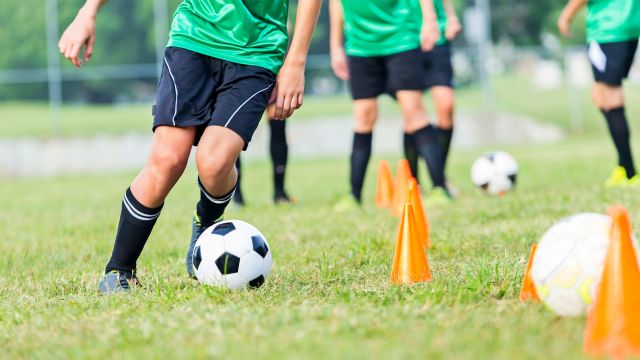For many students, the back to school routine usually involves seeing their doctor for a yearly checkup. Once kids reach middle school, high school and beyond, this routine visit often includes another type of exam: a sports physical.
A sports physical may be performed during a routine well-child visit, but it’s a separate exam. And depending on where you live and what schools your children attend, they may not be able to lace up for practice or competition without one. This is true whether they’re new to a sport or a returning player.
These brief medical exams attempt to screen for a wide-range of medical problems that would affect kids’ ability to play sports safely or increase their risk for injuries during physical activities. In extreme cases, sports exams can identify potentially life-threatening conditions, such as heart problems that could lead to sudden cardiac death.
On the flip side, these exams can also remove restrictions previously placed on your child if they are no longer necessary.
Passing a sports physical clears students, making them eligible to participate, explains Gregory Bratton, MD, a family practice and sports medicine doctor affiliated with Medical City Weatherford in Weatherford, Texas.
“Playing sports is dangerous enough,” says Dr. Bratton. “If you can lower any sort of risk, that’s important.”
Sports physicals vs. Routine yearly exams
Typically, a sports physical is called a “preparticipation physical evaluation” or PPE. This exam may not be accepted as a substitute for other, school-mandated annual physicals—or vice versa. There’s overlap between the two, but a routine, yearly “well visit” is generally more comprehensive, covering a wide-range of health discussions on topics like nutrition, sleep habits and physical development, as well as immunizations.
Sports physicals, on the other hand, focus on physical concerns, such as cardiac abnormalities or musculoskeletal issues, which have the potential to heighten a student’s risk of a health problem during physical activity.
“During sports physicals, we’re just trying to throw up the red flags that would alert us of a problem,” Bratton explains
What to expect
During a sports physical, your doctor will review your child’s medical history, focusing on specific issues that could potentially disqualify him or her from participation in a particular sport.
The American Academy of Pediatrics (AAP) endorses a standard list of conditions and questions for doctors to cover, which includes:
- Any existing medical conditions or family history of disease
- Past surgeries
- Previous heat-related illnesses
- Any medications your child takes, including supplements and herbal therapies
- Menstrual history in female athletes
- Concerns about weight, such as a history of rapid weight gain, attempts to gain or lose weight, or eating disorders
- Any heart-related conditions or concerns, particularly heart rhythm problems and high blood pressure
- Any lung or respiratory problems, such as asthma
- Past musculoskeletal problems or injuries
- Any prior concussion-like symptoms or traumatic brain injury
- Symptoms of anxiety or depression
- Sexual identity at birth and identifying gender
It’s worth noting that the APP updated its recommendations to include questions about mental health and gender identity in 2019. The revised guidelines also suggest that during sports physicals, doctors can address bullying, drug and alcohol use and birth control.
The wide-range of questions asked during the medical history—Have you ever had shortness of breath with activity? Have you ever passed out with activity? Have you ever had your physical activities restricted before?—will provide your doctor with valuable information, Bratton explains.
During a sports physical, your child’s height, weight and vision will be checked. A musculoskeletal exam will also be performed to identify or rule out any asymmetries, bone or joint abnormalities, posture or swelling that could signal a problem. A cardiac exam will also assess your child’s resting heart rate and blood pressure. The doctor will also listen for any heart murmurs or abnormal sounds.
Routine blood and urine tests are typically not part of a sports physical.
Where and when to get the exam
Whether or not your child needs to have a sports physical and how often the exam must be repeated depends on your state and your child’s school district. Some schools require students to undergo a sports physical every year, while others only mandate these exams for students entering a new level of schooling, such as the start of middle school or high school.
Some school districts’ rules about sports physicals are stricter than state requirements. Meanwhile, some recreational sports leagues may have no health requirements for participation, but these young people are not at any lower risk for sports-related medical concerns than athletes on school-sponsored teams and should be screened as well.
All student athletes should get a sports physical every year—even if it’s not required, Bratton advises “Things change. Injuries pop up,” he says. “Having a quick tertiary screening can give someone comfort that nothing really is going on.”
Ideally, your child should have a sports physical six to eight weeks before the season starts. The exam can be administered by your child’s pediatrician or primary care doctor.
Some schools offer sports physicals to members of the local community. In these cases, doctors volunteer their time, evaluating students at different stations, which focus on specific portions of the exam. Students rotate through the different stations until they’ve had a complete sports physical. Keep in mind however, your child’s doctor is more likely to conduct a complete sports exam and physicals offered by your school shouldn’t be a substitute for their annual checkup.
Managing possible concerns
If your child’s doctor identifies a potential issue that could interfere with sports or make participation risky, you may be referred to a specialist. For example, if your doctor finds an abnormal heart beat, your child may need to see a cardiologist who will hopefully clear him or her for participation in sports once the issue is ruled out, resolved or under control.
Additionally, if your child suffered a recent injury that required surgery, your doctor might request clearance from his or her surgeon, Bratton explains.
Scheduling a sports physical early on provides you with more time to see specialists and get follow up visits if they are needed. It also allows time for existing injuries to be rehabilitated or a child’s conditioning to improve before the season begins.
Having a chronic health issue doesn’t necessarily disqualify kids from participation in sports. In fact, most students are still able to play at some level after they’ve been evaluated and are receiving the appropriate treatment. Your child’s doctor will also take into account his or her age, maturity level, the specific sports involved and other factors when determining eligibility to participate.
Decisions to clear students for sports are made on a case by case basis. In every situation however, children’s safety and health are the most important consideration.






